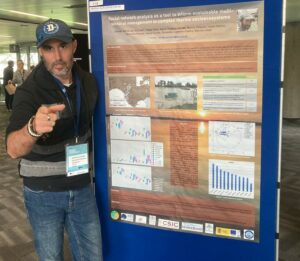On September 2022 in the ICES ANNUAL SCIENCE CONFERENCE, the SNAPQUIVIR team presented with a póster the first social network analysis of the coupled system Guadalquivir estuary-Gulf of Cádiz.

Here you can see the abstract and you can download the poster en la parte inferior de la barra derecha of this webpage.
Social network analysis as a tool to inform sustainable multi-sectoral management in complex marine socioecosystems
Alfredo García-de-Vinuesa*, Cesar Vilas, María Ángeles Torres, Marina Delgado, Isabel Muñoz, Fernando Ramos, David Florido, Remedios Cabrera-Castro, Marcos Llope
Contact: *Email: alfredo.gvinuesa@ieo.es Institution: Instituto Español de Oceanografía (IEO-CSIC), Centro oceanográfico de Cádiz. Address: Puerto Pesquero, Muelle de Levante, s/n, 11006 Cádiz, España.
Keywords: social network, participative process, socioecosystem, social engagement, ecosystem-based management.
In complex marine socioecosystems, where multiple sectoral activities coexist, management can be especially complicated. This is the case of the coupled Guadalquivir estuary – Gulf of Cadiz (Ge-GoC) system. The Guadalquivir estuary (SW Spain) plays a central role in the whole Gulf of Cadiz since many fish species use these waters as a nursery area. Therefore, not only fisheries management is important but also the environmental status of the estuarine waters. The latter will have an effect on the adult populations via recruitment. Human activities that directly or indirectly influence the estuary include fishing, agriculture, shipping, saltworks, tourism or aquaculture among other and conflict among them are common.
Multi-sectoral participative processes in natural resources management have proven successful as it engages users, legitimates decision-making and enables quick and proactive responses that eventually support conservation and restoration, now and into the future. Social network characterisation can be used to understand the relationships between sectors, helping us build a robust participative process. In this sense, we have used social network analyses as a first step to create an analysis and decision-support framework to achieve balanced socio-ecological ecosystem based management (EBM) to the Ge-GOC. We interviewed 53 actors from 10 different sectors related with the exploitation, management, research and conservation. We asked them about the number, frequency and type (e.g. power dynamics, friendliness, etc.) of the interactions between them as well as their particular management goals.
All actors showed great interest and stressed the need of participatory mechanisms where all sectors are represented. Centrality metrics (degree of relationship, closeness and betweenness) were used to identify actors with higher connections in the social network. The latter are good intermediaries between sectors and have wide capacity to reach out to the rest of actors. Among the 10 most relevant actors we found a research organization, shipping, decision makers, NGOs, fishermen’s guilds and universities. Regarding power dynamics, fishing, environmental decision makers and managers, and shipping were found to be most influential. In addition, water contamination, invasive species and illegal fishing were flagged as major socioecological problems.
Social network analysis has revealed as a useful tool to support the creation of participatory processes that could eventually be used to establish a legitimate co-management committee or any other form of institutional platform in support of sustainable and adaptive (EBM) governance for the ocean we want.
